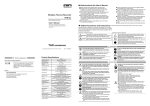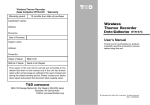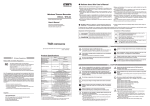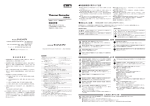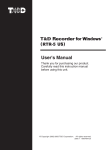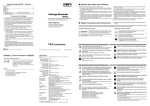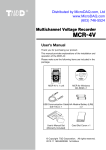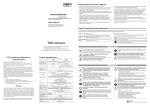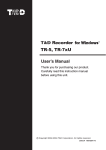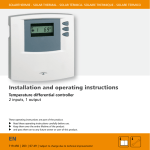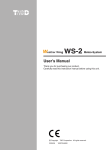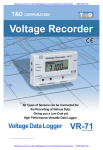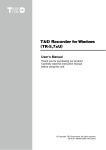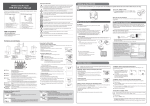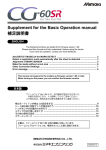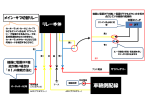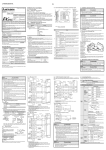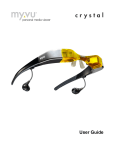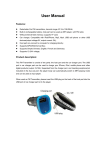Download User`s Manual
Transcript
User’s Manual Thank you for purchasing our product. Carefully read this instruction manual before using this unit. ��������� ��������� ��� ������������ ��� ������ ��������� 2004.04 16004264140 ■ Notices about this User’s Manual Carefully read this manual so that you can properly use this product. T&D Corporation accepts no responsibility for any malfunction of and / or trouble with this product or with your computer that is caused by the improper handling of this product and will deem such trouble or malfunction as falling outside the conditions for free repair of the attached warranty. ● All rights of this user’s manual belong to T&D Corporation. It is prohibited to use, duplicate and / or arrange a part or whole of this user’s manual without the permission of T&D Corporation. ● Microsoft and Windows are registered trademarks of Microsoft Corporation USA and are binding in the USA and all other countries. ● Company names and product names are trademarks or registered trademarks of each company. ● Specifications, without notice. design and other contents are subject to change ● On screen messages in this manual may vary slightly from the actual messages. ● Please notify the shop where you purchased this product or T&D Corporation of any mistakes, errors or unclear explanations in this manual. T&D Corporation accepts no responsibility for any damage or loss of income caused by the use of our product. ● This product has been designed for private or industrial use only. It is not for use in situations where strict safety precautions are necessary such as in connection with medical equipment, whether directly or indirectly. ● We are not responsible for any malfunction or trouble caused by the use of our product or by any problem caused by the use of measurement results of our unit. Please be fully aware of this before using our product. ● Some of our products, which come under the category of strategic goods in foreign trade law, need the permission of the Japanese government to be exported outside of Japan. ● This user’s manual cannot be reissued, so please keep it in a safe place. ● Please ⅰ carefully read warranty and provisions for free repair. Software User Agreement ■ Escape Clauses ● T&D Corporation does not guarantee the operation of T&D Recorder for Windows . ● T&D Corporation shall not accept any responsibility for any damage, whether direct or indirect, that results from the usage of T&D Recorder for Windows. ● Specifications of T&D Recorder for Windows may be subject to change and service may be terminated without advance notice to the user. In such a case, T&D Corporation shall not be responsible for any damages, whether direct or indirect, from the inability to use T&D Recorder for Windows. ● T&D Corporation has no obligation to correct any defects found in T&D Recorder for Windows. ■ Copyright ● The Copyright for T&D Recorder for Windows, including the program and relevant documents, belongs solely to T&D Corporation. ● The reprinting or redistribution for commercial purposes whether in part or in whole, in magazines or as a part of any product is strictly forbidden without the expressed consent of T&D Corporation. Any inquires concerning commercial redistribution should be directed to the Sales Department of T&D Corporation. ● Please do not attempt to make any changes or modifications to T&D Recorder for Windows. ⅱ Table of Contents Introduction ● Software User’s Agreement...................ⅱ ● What is T&D Recorder for Windows ? ........1 ● Communication with Data Loggers ............3 Getting Ready ● Installing the Software .......................5 ● Operating the Software ......................6 ● ● Computer Communication Settings ・Connecting the Communication Cable .......8 ・Setting Up the Serial Port ..................9 Remote Unit Registration.....................11 ・Other Remote Unit Registration Functions ....16 Basic Functions ● ● ● ● ⅲ RTR-51/52 ・Start Recording ...........................21 ・Downloading Recorded Data ...............23 RTR-53 ・Start Recording ...........................25 ・Downloading Recorded Data ...............28 RVR-52 ・Start Recording ...........................29 ・Downloading Recorded Data ...............32 RTR-57C ・Downloading Recorded Data ...............33 ・Set Clock ................................39 ・Set Upper and Lower Limits ................40 Temperature and Humidity Graph ● ● Display Names and Functions ................41 Editing the Graph ・Changing the Graph Display ................45 ・Graph Operation ..........................50 Multi-Scale Graph ● ● Display Names and Functions ................51 Editing the Graph ・Changing the Graph Display ................55 ・Graph Operation ..........................62 Event Viewer ● Display Names and Functions ................63 ● File Information .............................65 ● Printing Preview and Printing .................66 ● Saving Recorded Data .......................67 ● Creating Text File ...........................69 ● Opening Data Files ..........................71 ● Re-installation ..............................72 ● Troubleshooting.............................73 ● Specifications...............................77 Other Functions Other ⅳ What is T&D Recorder for Windows ? ■ Outline By using T&D Recorder for Windows, you can easily display the data measured and recorded with the RTR-51/52/53, RVR-52 via our exclusive short-wave wireless technology in table or graph form and control printing with your computer. Upon opening T&D Recorder for Windows, a launcher window in which icons are displayed will appear. By clicking an icon, the graph, settings, and /or communication screen for that type of unit will be displayed. This software requires the following operating environment: Compatible OS Microsoft Windows 98 / Me / NT 4.0 Microsoft Windows 2000 / XP PC / CPU IBM compatible equipped with more than Pentium 90MHz or NEC 98 Series with serial communication (RS-232C D-Sub 9 pin). Memory More than16MB memory capacity Hard Disk More than 4MB of empty hard disc space Monitor VGA (Above SVGA (800×600) is recommended) More than 256 colors can be displayed ■ Basic Functions ● Group and Remote Unit Registration If you wish to carry out wireless communication between an RTR-57C unit and RTR-51/52/53, RVR-52 unit, it is necessary to first complete via computer the remote unit registration of the RTR-51/52/53, RVR-52 unit to the RTR-57C. Remote units can be operated and managed in Groups. ● Display of Data List Collected in RTR-57C A list of all data collected at the time of downloading is displayed, from which all or part of the data can be used to create files or graphs. ● Mixed Use with Other Units is Possible You can make graphs in which data from RTR-51/52/53 and RVR-52 units are mixed. If TR-5/TR-7 Series data have been read into the RTR-57C unit, management of such mixed data is also possible. ● Temperature and Humidity Graph / Multi-Scale Graph In temperature and humidity graphs, the graph or list of temperature and humidity data is displayed. In multi-scale graphs, the graph or list of voltage, pulse, temperature and humidity data is displayed. You can also set the scale or units to match the type of downloaded data. 1 Can Display 8 Channels of Data in One Graph Can simultaneously display up to 8 channels of recorded data downloaded from a main unit in one graph. Printing Graphs and Data Lists You can print graphs displayed on screen in full color. When printing a data list, the printing of every recording date is possible. Measured Data List Display In the measured data list display, the maximum, minimum, and average values are shown in different colors. ● Event Viewer In the event viewer, a data list showing the time of events is displayed. Print Preview and Print Select the data to be printed and after checking it in the preview window you can proceed to print. ● Creating Text File Recorded data can be saved in universal Text file format (such as CSV Format) to be read and manipulated by all common spreadsheet software such as Excel or Lotus. 2 Communication with Data Loggers There are two methods to communicate with RTR-51/52/53, RVR-52 data loggers; they are [Optical Communication] and [Wireless Communication]. ■ Optical Communication By using the communication cable, you can carry out direct communication with a computer or with an RTR-57C unit. 1.Using the supplied communication cable, connect the RTR-57C to your computer. ゲ ク ューイア ター ト ンサ メニタス モニ リス ケ ン デー ド アゲ サ・ コキ メイWL オン スイ シ ソウ WL WL タ カイ タ デー ク デー キロ llec Co t t Lis 2.To carry out communication, place the data logger face down on the RTR-57C. ゲ ー アク ュ イサ ー ニ スン タ ト メ タケ ニ ス ー モゲ リ ン デ キ ア ・ イ L コ ドイ サ メ W L オン ス ウ シ W L ソイ タ Wー カ タ デ ー ク デロ キ Place the data logger face down. Connect to Computer It is possible to carry out some operations such as recording start settings or changes, and downloading recorded data via communication with an RTR-57C unit without connecting to a computer. For details, please see the RTR-57C User’s Manual. ゲ ー ア ュ イ ク ー ニ ス サ タ ト メ タ ン ニ ー ケ モゲ ス ン デ ア リ イ L キ ドイ ・ メ W L コオン ス ウサ W L ソ イシ W ータ カ デ ータク デ ロ キ 3 ■ Wireless Communication Downloading recorded data from a data logger in the field to an RTR-57C unit can be carried out via wireless communication (Special Short-wave Radio Data Communication). 1.Register the Remote Unit. Via the RTR-57C, connect a data logger to your computer and using the T&D Recorder for Windows software register that data logger as a Remote Unit. 2.Place the Remote Unit in the actual place where you wish to make measurements. If direct and unobstructed, the communication range is about 100 meters. Group メイン メニュー WL データスイアゲ WL コキ ケンサク WL オンド モニター データ スイアゲ データ ソウサ・リスト キロク カイシ Collect List 100m ● If direct and unobstructed, the communication range is about 100 meters. 3.Carry out the Wireless Communication Test. There are instances when communication cannot occur within 100 meters. Please check to see if communication is possible by running a Search for Remote Units that have been registered via the RTR-57C. 4 Installing the Software ● Is Windows working properly? If Windows is not activated properly, it may be impossible to install and run T&D Recorder for Windows. ● Quit all applications. If you are running other applications, make sure to quit them before installation. If you have any permanently active software, such as a virus check or scan program in your computer, make sure to also quit it. ■ Install the Software (T&D Recorder for Windows) 1.Start Windows. 2.Place the CD-ROM in the appropriate drive, and the 「Install Program」 window will automatically open. ● If that window does not open automatically, open the 「My Computer」 window and double-click on the icon for the CD-ROM. [Install T&D Recorder for Windows] [START] button 3.Select [Install T&D Recorder for Windows] and by clicking on the [START] button the installation will begin. 4.Confirming the contents as you go, install the software according to the directions. After installation is completed, an icon for [T&D Recorder for Windows] will appear in the Start Menu. 5 Operating the Software ■ Opening the Software Open the software by clicking on [T&D Recorder for Windows] from the list of programs in the Start Menu. ■ Main Window Upon opening T&D Recorder for Windows, a launcher window in which icons are displayed will appear. By clicking an icon, the graph, settings, and / or communication screen for that type of unit will be displayed. Menu Bar Toolbar Icon ● Menu Bar In the Menu Bar are Menus containing an array of commands. Click on the desired menu in the menu bar to set or display functions for each type of device. By clicking [Display]-[ Change Icon Layout ] or [Change Icon Size], you can select how you wish the Main Window to appear. [Setting] Menu: Date Display Format Settings It is now possible to choose the date format displayed this software. The date format chosen will be applicable for all sections of the software including graphs and setting displays. 1.In the [Setting] Menu, select [Date Display Format Settings]. 2.Check either [Month/Day/Year] or [Day/Month/Year]. [OK] button 3.By clicking the [OK]button, the setting will be completed. ● Toolbar Can choose to view or hide icons. You can also make this setting from the Menu Bar by clicking [Start]-[Select Menu]. ● Icons By clicking on an icon, the graph or communication display will appear for that type of unit. The graph and communication displays for each type of unit can also be viewed by clicking on that unit’s type name in [Start] of the Menu Bar. 6 ■ See the Help Menu of the software for more detailed information about how to use the software. ● To search for unclear words or terms, click the [Help] Menu that appears in the Menu Bar and then click on one of the tabs [Contents], [Index] or [Search]. Contents Index Search 〔Contents〕 By clicking the mark of the classified topic, an explanation will be displayed. 〔Index〕 Select a key word from the key word list and by clicking the [Display] button, the explanation will be displayed. 〔Search〕 Enter the key word you wish to search for and click the [Start Search] button and the topic in which the key word is included will be displayed. Then select the topic and click the [Display] button to have the explanation displayed. ● Click on the [Help] button in any dialog box and explanations about the dialog box will be displayed. ● In the graph display window, after clicking on the in the toolbar, you can click on any Menu, any Icon, or any part of the Main window and an explanation will be displayed. 7 Computer Communication Settings ■ Connect the communication cable to your computer. Connect the RS-232C communication cable (included in pack) to the serial port of your computer. Serial Port Markings The communication cable connection is a D-Sub 9 pin female. Please connect it to a port that has markings such as these. Note: If the cable is connected to the wrong port, communication cannot take place. ● Be sure to securely connect the cable to avoid any communication failure due to a loose connection. ● ■ Connect the Data Logger to your Computer. If the data logger is an RTR-51/52/53, or RVR-52 unit, connect it to your computer via an RTR-57C unit. ゲ ー アク ュ イサ ー ニ スン タ ト メ タケ ニ ス ー モゲ リ ン デ キ ア ・ イ L コ ドイ サ メ W L オン ス ウ シ W L ソイ タ Wー カ タ デ ー ク デロ キ Place the data logger face down on the RTR-57C. Connect the communication cable from your computer to the RTR-57C unit. 8 ■ Setting Up the Serial Port Set the serial port to be used for communication with the data logger. There are two ways to set up the serial port [Auto Detect] and [Select a Port]. ● When you wish to use the same COM port to carry out communication with different types of units. Check [Set Common COM Port for All Types] and click the [OK] button to complete at once the port setting for all types of units. [Auto Detection] [Serial Port Settings] tab Detection Results [Auto Detect] button When setting up more than one type at the same time [OK] button [Close] button 1.In the main window, open the setting, communication display of the type of data logger connected to the computer and click the [Serial Port Settings] tab. 2.Click the [Auto Detect] button to start the detection process. 3.When the detection is completed, a message will be displayed in the [Detection Results] section. 4.By clicking the [OK] button, the setting process will be finished and the port to which the data logger is connected will be set. 5.By clicking the [Close] button, the setting will be completed. 9 [Selecting a Port] [Serial Port Settings] tab Possible COM Ports When setting up more than one type at the same time [OK] button [Close] button 1.Click the [Serial Port Settings] tab in the settings / communication display of the data logger to be used. 2.From the [Possible COM Ports] list box choose and check the port to which the data logger is connected. 3.Click [OK] button to finish set-up and close the dialog box. 4.By clicking the [Close] button, the setting will be completed. 10 Remote Unit Registration ■ Registering a Remote Unit 1.By selecting the icon [Remote Unit Registration], a message will be displayed. ※ Remote unit registration can be carried out for each type of unit from the setting / communication menu for that unit [Communication]- [Remote Unit Registration]. 《Enlarged Message》 [Yes] button Collect Registration Info This function allows you to collect all remote unit registration info in the RTR-57C. That info (Group Name / Remote Unit Number / Remote Unit Name) will be displayed in a list. In order to delete, change or register any groups or remote units in an RTR-57C, it is necessary to connect that RTR-57C to your computer and carry out the [Collect Registration Info] before proceeding. 2.By clicking the [Yes] button, collection of the registration info will begin and a list will be displayed. The default setting for the registered group name is [Group 1]. Remote unit registration into [Group 1] is possible. 11 ● If the registration info has not been collected or you wish to collect again, click [Collect Registration Info] button in the [Registration Contents] window to collect the registration info. [Collect Registration Info] button 3.Click the [Register] tab, and set the Group Name, Remote Name, and Communication Frequency Channel. [Register] tab Group Name Communication Frequency Channel Remote Unit Name [Register] button [Close] button ● Group Names Group Names can be entered with up to 8 letters. You can also select an already registered group name and make slight changes to make a new name. 12 ● Communication Frequency Channel By clicking the [Set] check box you can select a channel number. One Frequency Channel (0-3) can be set for each Group. 《Remote Registration Display》 ● ● The default frequency channel setting for Group 1 is ‘0’ If no settings are chosen, an unused frequency channel will be automatically assigned. NOTE: ● A frequency channel setting can only be made when registering a new group. ● Once a channel has been set for a group it cannot be changed. ● The specified frequency channel will be used for all communication with remote units in that group. If another RTR-57C is using the same channel in the same area, communication may become unstable. ● Remote Names Remote Names can be entered with up to 8 letters. You can also select an already registered remote name and make slight changes to create a new name. 4.By clicking the [Register] button, registration will be completed. ● If you are registering a number of remote units to the same group, place each one on top of the RTR-57C and carry out the registration into the same group. ● If you are registering units to different group names, please follow the above steps over again. 13 5.Upon completion the [Registration Contents] will be displayed and by clicking [Close] the registration will be finished and the window closed. [Close] button ● By clicking on a Group Name, the Frequency Channel for that group, as well as, the Remote Unit Names and Numbers for that group will be displayed. Frequency Channel Number of Possible Registrations Remote Number and Name 《[Registration Contents] display enlargement》 14 ■ Position the remote unit(s)in the place(s)where you want to measure and check if communication is possible. From an RTR-57C unit, it is possible to find any registered Remote Unit and make sure communication can be carried out. 1.In the Main Window, activate [Find Remotes]. 2.Choose the range in which to search and activate. ● If you choose [All Groups], the search for remotes in all registered groups will begin immediately. ● If you choose [Specify Group], select the desired group from the list to start the search. 3.After the search has been completed, a list of possible Remote Units for communication will appear in a list. ● Remote an Units for which communication is possible will be marked with before its name. For details, see the RTR-57C User’s Manual. 15 Other Remote Unit Registration Functions The following operations can be carried out in the Remote Registration Window. Be sure to connect the RTR-57C to your computer and collect the registration info of RTR-57C before carrying out these operations. [File] Menu [Collect Registration Info] button [Return to Original] button [Send] button [Set Number of Possible Registrations] button ■ 「File」Menu: [Save Registration Contents] You can save the Group and Remote Unit Registration Info to a file. NOTE: ● You cannot edit the contents of registration info from a saved file. ● You cannot send text file. 1. From the [File] Menu, choose [Save Registration Contents to File]. 2. Designate the saving location and enter a file name. 3. Click the [Save] button to save the file. 16 ■ [File] Menu: [Save as Text File] You can save the Group and Remote Unit Registration Info as a text file. NOTE: You cannot edit the contents of registration info from a saved file. 1. From the [File] Menu, choose [Save as Text File]. 2. Designate the saving location and enter a file name. 3. Click the [Save] button to save the file. ■ [Set Number of Possible Registrations] Button There are two patterns for setting and registering the largest number of groups and remotes into one RTR-57C. ・Pattern 1: <Group Numbers: 60 / Remote Numbers in 1 Group: 64> ・Pattern 2: <Group Numbers: 15 / Remote Numbers in 1 Group: 250> The Default Setting is: Pattern 1: <Group Numbers: 60 / Remote Numbers in 1 Group: 64> NOTE: If changes are made to the pattern, the Remote Unit Registration Contents saved in the RTR-57C will be automatically returned to the original default contents. Please be careful. 1. Select a pattern. 2. Click [OK] button to complete the change. Check one 17 [OK] button ■ [Remote Registration Contents] – [Return to Original] Button All info saved in the RTR-57C will be erased and will be returned to as it was when it left the factory: Group Name: Group 1 / Remote Unit: NONE / Communication Frequency: 0 1. Connect the RTR-57C unit you wish to return to the factory settings. 2. Click the [Return to Original] button, and the process will begin. ■ [Remote Registration Contents] – [Send] Button If the Registration Contents are the same in a number of RTR-57C Units, communication is possible between 1 Remote Unit and any number of RTR-57C Units. To make the contents the same, it is possible to transmit them to a number of RTR-57C Units. NOTE: ● By sending, you will delete all prior registration contents. ● If the number of files to be sent is over the number of possible registrations, it will be impossible to transmit them. Please see p.17 for details about the possible number of registrations. 1. Save the registration contents you wish to send. (See p. 16 for details) 2. Click [Open] from the [File] Menu and open those Remote Registration Files you wish to send. 3. The contents of those files will be displayed in the Remote Registration Contents Window. 4. Click the [Send] button to begin transmission. 18 ■「Change / Delete」 You can make changes to a registered Remote Unit Name or delete a Group or Remote Unit. [Change] button [Delete Group] button [Delete Remote Unit] button [Change] Button…Only for Remote Names 1. Select the Group in which the Remote you wish to change is registered. 2. Select the Remote Number or Name and enter the new Remote Name for the unit. 3. Click the [Change] button to send the new information. [Delete Group] Button By deleting a Group, all Remote Units registered to that Group will be automatically deleted. 1. Select the Group Name you wish to delete. 2. Click [Delete Group] to begin the process. [Delete Remote] Button 1. Select the Group Name in which the remote you wish to delete is registered, then select the Remote Number(s) or Name(s). 2. Click [Delete Remote Unit] to begin the process. 19 ■「Remote Unit Info」 This allows you to view the registration contents of any Remote Unit presently connected to the RTR-57C. The Registration Contents of units registered to a different RTR-57C can be viewed as well. 1. Place the Remote Unit from which you wish to collect remote info face down on the RTR-57C. 2. Click the [Collect Remote Unit Contents] button and the info will appear for that unit. [Collect Remote Unit Contents] button ● RTR-57C Registration Status: ● Wireless Recording Start If remotes are registered in the presently connected RTR-57C : exist If remotes are not registered in the presently connected RTR-57C : Not exist If registration info has not been collected from presently connected RTR-57C :- If forbidden to start recording: FORBID If permission to start recording: PERMIT 20 RTR-51/52: Start Recording 1.In the main display, click the icon [RTR-51/52]. 2.Click the [Start Recording] tab and make recording settings. 「Start Recording」 tab [Start Recording] button [Get Settings] button [Detailed Settings] button [Stop Recording] button [Close] button ● Recording Start Date / Time: <Select: Programmed Start / Immediate Start> Select the Recording Start Method ・Programmed Start: Recording will begin on the day and time entered. ・Immediate Start: Recording will begin as soon as settings are completed. ● Recording Interval: <Select from: 1,2,5,10,15,20,30 seconds or 1,2,5,10, 15,20,30,60 minutes> By clicking ▼ you can select from the recording interval list. ● Recording Mode: <Select from: One-time / Endless> One-time: When the number of readings has reached 16,000, the unit display will read FULL and recording will automatically stop. Endless: When the number of readings reaches 16,000, the next one will overwrite the oldest or first reading. ● Temperature 。 Unit: <Select from: Celsius [℃ ] or Fahrenheit [ F] > 。 Change the display of temperature on the Thermo Recorder between [℃ ] and [ F] . ※ By clicking the [Get Settings] button, registration contents and remaining battery life will be displayed. 3. After making all the desired settings, click the [Start Recording] button to transmit them. 4.After transmission has been completed the communication result will appear. By clicking [OK], the set-up process will be finished. By clicking [Close], you can close the window. 21 ■ [Get Settings] Button The Remote Unit recording settings, registration contents, and remaining battery life are displayed. ● Registration contents: If a settings transmission was received it displays the Group and Remote Name(s). ● Remaining battery life: If a settings transmission was received it displays the remaining battery life. ■ [Detailed Settings] Button [OK] button Check one By checking, you can make entries. ● Start Wireless Communication: Restrict the permission to start recording by wireless communication. 1.If you wish to forbid the starting of recording by wireless communication, check [FORBID]; to allow, check [PERMIT]. 2.Click [OK] to complete and close. ● Upper and Lower Limits: To check whether or not the data downloaded into the RTR-57C falls within a certain set range. 1.By checking the [Set Limits] box, you will be able to enter an upper and lower limit. 2.Click [OK] to complete and close. ■ [Stop Recording] Button Stop current recording of data logger. 22 RTR-51/52: Downloading Recorded Data ■ Connect the RTR-51/52 unit for communication with your computer. ※ See P.3 or P.8 for about how to connect. ■ Download Recorded Data. 1.In the main window, click the icon [RTR-51/52]. 2.Click the [Download Recorded Data] tab. [Download Recorded Data] tab Select the downloading range [Download] button [Detailed Settings] button [Close] button 3.After selecting the downloading range, click the [Download] button to start downloading. 4.When downloading has been completed a graph will be displayed. If you have checked [After downloading, specify file in which to save data] in the Detailed Settings, please view the graph after specifying the file in which you wish to save the downloaded data. 23 ■ [Detailed Settings] Button You can make settings for the processing of the downloaded recorded data. 1. Select the desired processing method. 2. Click [OK] button to complete the setting. Check one [OK] button 24 RTR-53: Start Recording 1.In the main window, click the icon [RTR-53]. 2.Click the [Start Recording] tab and set the recording conditions. 「Start Recording」 tab [Start Recording] button [Get Settings] button [Detailed Settings] button [Stop Recording] button [Close] button [Main Unit Display Settings] button ● Recording Start Date / Time: <Select: Programmed Start / Immediate Start> Select the Recording Start Method ・Programmed Start: Recording will begin on the day and time entered. ・Immediate Start: Recording will begin as soon as settings are completed. ● Recording Interval: <Select from: 1,2,5,10,15,20,30 seconds or 1,2,5,10, 15,20,30,60 minutes> By clicking ▼ you can select from the recording interval list. ● Recording Mode: <Select from: One-time / Endless> One-time: When the number of readings has reached 8000, the unit display will read FULL and recording will automatically stop. Endless: When the number of readings reaches 8000, the next one will overwrite the oldest or first reading. ● Temperature 。 Unit: <Select from: Celsius [℃ ] or Fahrenheit [ F] > 。 Change the display of temperature on the Thermo Recorder between [℃ ] and [ F] . ※ By clicking the [Get Settings] button, registration contents and remaining battery life will be displayed. 3. After making all the desired settings, click the [Start Recording] button to transmit them. 25 4.After transmission has been completed the communication result will appear. By clicking [OK], the set-up process will be finished. By clicking [Close], you can close the window. ■ [Main Unit Display Settings] Button Set the desired unit of measurement display for the RTR-53 unit LCD display. 1.Select the unit of display you wish to set. 2.Click the [Send] button to complete the setting. Check one [SEND] button ■ [Get Settings] Button The Remote Unit recording settings, registration contents, and remaining battery life are displayed. ● Registration contents: If a settings transmission was received it displays the Group and Remote Name(s). ● Remaining battery life: If a settings transmission was received it displays the remaining battery life. 26 ■ [Detailed Settings] Button Check one [OK] button By checking, you can make entries. ● Start Wireless Communication: Restrict the permission to start recording by wireless communication. 1.If you wish to forbid the starting of recording by wireless communication, check [FORBID]; to allow, check [PERMIT]. 2.Click [OK] to complete and close. ● Upper and Lower Limits: To check whether or not the data downloaded into the RTR-57C falls within a certain set range. 1.By checking the [Set Limits] box, you will be able to enter an upper and lower limit. 2.Click [OK] to complete and close. ■ [Stop Recording] Button Stop current recording of data logger. 27 RTR-53: Downloading Recorded Data ■ Connect the RTR-53 unit for communication with your computer. ※ See P.3 or P.8 for about how to connect. ■ Download Recorded Data. 1.In the main window, click the icon [RTR-53]. 2.Click the [Download Recorded Data] tab. [Download Recorded Data] tab Select the downloading range [Download] button [Detailed Settings] button [Close] button 3.After selecting the downloading range, click the [Download] button to start downloading. 4.When downloading has been completed a graph will be displayed. If you have checked [After downloading, specify file in which to save data] in the Detailed Settings, please view the graph after specifying the file in which you wish to save the downloaded data. ■ [Detailed Settings] Button You can make settings for the processing of the downloaded recorded data. Check one [OK] button 1. Select the desired processing method. 2. Click [OK] button to complete the setting. 28 RVR-52: Start Recording 1.In the main display, click the icon [RVR-52]. 2.Click the [Start Recording] tab and make recording settings. [Start Recording] button 「Start Recording」 tab [Get Settings] button [Detailed Settings] button [Stop Recording] button [Close] button ● Recording Start Date / Time: <Select: Programmed Start / Immediate Start> Select the Recording Start Method ・Programmed Start: Recording will begin on the day and time entered. ・Immediate Start: Recording will begin as soon as settings are completed. ● Recording Interval: <Select from: 1,2,5,10,15,20,30 seconds or 1,2,5,10, 15,20,30,60 minutes> By clicking ▼ you can select from the recording interval list. ※ In event recording, the interval is always 1 second. ● Recording Mode: <Select from: One-time / Endless> One-time: When the number of readings has reached 16,000, the unit display will read FULL and recording will automatically stop. Endless: When the number of readings reaches 16,000, the next one will overwrite the oldest or first reading. ※ In event recording, the number of readings is 8,000. ● Measurement Mode: <Select: Voltage / Pulse> Voltage/Instantaneous Value: Record the voltage measurement as the instantaneous value for each recording interval span. 29 Voltage/Average Value: Record as the average value for each recording interval span. The average value for recording intervals under 15 seconds will be calculated as the average of the measurements from every 1 second. The average for intervals over 20 seconds will be calculated as the average of the measurements from every 2 seconds. Pulse/ Lo→Hi: Record the number of signals rising within the recording interval you have set. Pulse/ Hi→Lo: Record the number of signals falling within the recording interval you have set. Pulse/ Event: Record the time of any event; a rising (Lo to Hi) or falling (Hi to Lo) waveform that occurs for more than 1 second at an input voltage range of between 0-30V. ※ By clicking the [Get Settings] button, registration contents and remaining battery life will be displayed. 3. After making all the desired settings, click the [Start Recording] button to transmit them. 4.After transmission has been completed the communication result will appear. By clicking [OK], the set-up process will be finished. By clicking [Close], you can close the window. ■ [Get Settings] Button The Remote Unit recording settings, registration contents, and remaining battery life are displayed. ● Registration contents: If a settings transmission was received it displays the Group and Remote Name(s). ● Remaining battery life: If a settings transmission was received it displays the remaining battery life. 30 ■ [Detailed Settings] Button [OK] button Check one By checking, you can make entries. ● Start Wireless Communication: Restrict the permission to start recording by wireless communication. 1.If you wish to forbid the starting of recording by wireless communication, check [FORBID]; to allow, check [PERMIT]. 2.Click [OK] to complete and close. ● Upper and Lower Limits: To check whether or not the data downloaded into the RTR-57C falls within a certain set range. 1.By checking the [Set Limits] box, you will be able to enter an upper and lower limit. 2.Click [OK] to complete and close. ■ [Stop Recording] Button Stop current recording of data logger. 31 RVR-52: Downloading Recorded Data ■ Connect the RVR-52 unit for communication with your computer. ※ See P.3 or P.8 for about how to connect. ■ Download Recorded Data. 1.In the main window, click the icon [RVR-52]. 2.Click the [Download Recorded Data] tab. [Download Recorded Data] tab Select the downloading range [Download] button [Detailed Settings] button [Close] button 3.After selecting the downloading range, click the [Download] button to start downloading. 4.When downloading has been completed, a Graph or Event Viewer will be displayed. If you have checked [After downloading, specify file in which to save data] in the Detailed Settings, please view the graph or Event Viewer after specifying the file in which you wish to save the downloaded data. ■ [Detailed Settings] Button You can make settings for the processing of the downloaded recorded data. Check one [OK] button 1. Select the desired processing method. 2. Click [OK] button to complete the setting. 32 RTR-57C: Downloading Recorded Data ■ Connect RTR-57C to your computer to carry out communication. ※ For details about how to connect, see the user’s manual for RTR-57C. ■ Collect RTR-57C Data Info. 1.In the main window, click the icon [RTR-57C]. 2.Click the [Download Recorded Data] tab. [Download Recorded Data] tab [Collect Data Info] button 3.By clicking the [Collect Data Info] button, communication will be started and the data list saved in RTR-57C will be displayed. Data List [Quit Collecting Data Info] button 33 【Quit collecting data info while in progress】 By clicking [Quit Collecting Data Info], the collection will be stopped. ① ② ① Collection of data info has been completed. All operations are possible. ② Data downloading and deletion can be done, but data info cannot be displayed. ■ Download Recorded Data. 1.Select the data to be downloaded from the data list. ※ To download several sets of data at one time, see p.36-37 for details. Select data 34 2.By clicking the [Download] button, downloading will be started. [Cancel Downloading] button ● By clicking the [Cancel Downloading] button, you can stop downloading at any time. 3.When downloading has been completed, the graph will be displayed. ※ If you have checked [After downloading, specify file in which to save data] in the Detailed Settings, please view the graph after specifying the file in which you wish to save the downloaded data. ■ [Detailed Settings] Button You can make settings for the processing of the downloaded recorded data. 1.Select the desired processing method. 2.Click [OK] button to complete the setting. Check one 35 [OK] button ■ Downloading Several Sets of Data at One Time You can make settings for the processing of the downloaded recorded data. 1.While holding down the [Shift] key or [Ctrl] key, click on those sets of data you wish to download. (For Example) ● If you wish to download files not in a row, such as No.1 and No.3, hold down the [Ctrl] key and click on files for No.1 and No.3. ● If you wish to download files in a row, such as No.1, No.2 and No.3, hold down the [Shift] key and click on the files for No.1 to No.3. Use the [Shift] key to select Use the [Ctrl] key to select 2.Click on the [Download] button, and downloading will be started. [Cancel Downloading] button 3.When downloading has been completed, a graph will be displayed. ※ If you have checked [After downloading, specify file in which to save data] in the Detailed Settings, please view the graph after specifying the file in which you wish to save the downloaded data. 36 ● If you have checked [After downloading, specify file in which to save data] and you have selected several sets of data, at the end of the specified file name of every recorded data will appear the list number (No.1→001, No.2→002,No.3→003…) File Name List Number Extension Code trx : Universal Thermo Recorder type file vtc : Voltage Recorder type file pv5 : RVR-52 voltage, pulse data file rp7 : RVR-52 event data file ● If you have checked [After downloading, automatically show graph] and have selected several sets of data, it is possible to display the selected data in the same graph. Moreover, in the graph display by entering which file you wish the data to be saved, it is possible to save several sets of data into one file. ※ Each kind of data is displayed in the following graphs: Temperature/Humidity data: Temperature/Humidity Graph Voltage/Pulse data: Multi-scale Graph Event data: Event Viewer 37 【Other Button Functions】 ① ② ③ ④ ① [Data Info Display] Button Displays info about data for all selected data from the list. ② [Delete Data] Button Deletes selected data saved in the RTR-57C from the software. ③ [Delete All Data] Button Deletes all data saved in the RTR-57C from the software. ④ [Select All] Button Selects all data in list to be downloaded at the same time. 38 Setting the RTR-57C Clock Set the RTR-57C clock from your computer. 1.In the main window, click the icon [RTR-57C]. 2.Click the [Set Clock] tab [Set Clock] tab [Close] button [Set Clock] button ● Set specified time If checked: The date/time you enter will be set as the date/time in the RTR-57C. If not checked: The current date/time of your computer will be set as the date/time in the RTR-57C. 3.Select setting method and by clicking the [Set Clock] button, the setting will be transmitted. 4.Click [Close] button to complete the setting. 39 RTR-57C Upper and Lower Limits RTR-57C Upper and Lower Limits can be set from your computer. Setting is directly possible in RTR-57C Main Units version 2 or higher. The version can be confirmed in [Help]-[RTR-57C Version Info]. See the Help Menu in T&D Recorder for Windows for details. 1.In the main window, click the icon RTR-57C. 2. Click the [Upper and Lower Limit Settings] tab, and check the <Change> box. [Upper and Lower Limit Settings] tab Enter upper and lower limit values. Check ON/OFF Check <Change> [Write] button [Close] button [Read] button 3.After entering the upper and lower limit values, check <ON> and by clicking the [Write] button, the information will be transmitted. ON: Judges whether recorded data is within the set range when RTR-57C has downloaded the recorded data. OFF: Judgment isn’t carried out even if upper and lower limits have been set. 4.Click [Close] button to complete the setting. ■ [Read] Button If you wish to view the current settings, click the [Read] button. 40 Temperature/Humidity Graph ■ How to Open Open the Graph display by clicking the icon [Temp/Humid Graph] in the Main Window. Click ● In the Main Window or in the Settings/Communication Display of RTR-57C, RTR-51/52, or RTR-53, select the [Temp/Humid Graph] from the [Start] menu to open the graph. ● If you have clicked [Display the graph after downloading recorded data], the graph will automatically open. ■ Display Names and Functions ⑤ ⑥ ④ ③ ⑦ ② ⑧ ① ⑨ ⑩ 41 ① A and B Cursor Movement Buttons By clicking the arrow buttons, you can simultaneously move the A/B cursors. ② A and B Cursor Buttons Click and drag the A or B button to move the cursor to the left or right. ③ Toolbar Buttons appear for frequently used commands. ① ② ③ ④ ⑤ ⑥ ⑦ ⑧ ⑨ ⑩ ⑪ ⑫ ⑬ ⑭ ① Open File ② Overwrite Data ③ Save Data as… ④ Change Data Display Colors ⑤ Data Display ON/OFF ⑥ Return to Original Size ⑦ Step-by-Step to Original ⑮ ⑧ Set High, Low, Avg. ⑬ Print Calculation Range ⑭ Help ⑨ Edit Recording Conditions ⑮ Hide / View Channels ⑩ Re-order Channels ⑪ Erase Selected Channels Data ⑫ Vertical Axis Settings ④ Menu Bar Click on the desired menu in the Menu Bar to set or display each function from which you can choose from an array of commands. ⑤ Button for Moving Horizontal Axis The time axis moves by clicking these arrow buttons. ⑥ Horizontal Gauge Bar By dragging the gauge you can move left and right to the data you want to be displayed. ⑦ Button for Moving Vertical Axis The vertical axis moves up or down by clicking these arrow buttons. ⑧ Vertical Gauge Bar By dragging the gauge you can move up and down to the data you want to be displayed. ⑨ A and B Cursor Position Information ⑩ Channel Info List Display Displays data information for Channels 1 to 8. 42 ● Zoom in Using the Mouse With the left button drag the mouse to outline the area you want to zoom in on. ● Menu Display Using the Mouse By right clicking on the graph, the Menu will be displayed. 43 ■ Data List Display ● [Date / Time] Button By clicking this button, you can shift the display between the recorded date and amount of elapsed time since recording started. ① Recorded Date Display [Date / Time] Button ② ① This is a list of the data that was displayed in graph form. The highest value is in RED, lowest is in BLUE, and the average is in PINK. ② Scroll Bar: By dragging it up and down you can move to the data you want. Elapsed Time Display ● Menu Display Using the Mouse By right clicking on the list, the Menu will be displayed. 44 Editing the Graph ■ Changing the Graph Display ● Changing graph display colors: From the [View] Menu You can change the letters used in the data list display for each channel between monochrome and channel color ● Selected Channels ON/OFF: From the [View] Menu 1.The channel numbers are displayed in the pull down menu of [Selected Channels ON/OFF]. 2.Check the channel numbers you wish to display. Check 《Enlarged》 ※ By clicking a Channel Number in the Toolbar, you can carry out the same operation. ● Set High, Low, Average Calculation Range: From the [Tools] Menu 1.Set the calculation range in [Set High, Low, Avg. Calculation Range] box. [OK] button Enter the numerical value. 45 [Entire Graph] button ● [Entire Graph] Button To make the Calculation Range that of the Entire Graph, click the "Entire Graph" button. The dates and times in the [Set High, Low, Avg. Calculation Range] box will be displayed as those of the entire graph. ● Set by using the AB Cursors In the Graph Display, open the [Set High, Low, Average Calculation Range] box adjusting the AB cursors to the desired start and end positions. The dates and times of those cursors will be displayed automatically. 2.By clicking the [OK] button, the high, low, average calculation range of each channel data will be changed. On the graph display, the calculation range that you have set will be displayed. ● Edit Recording Conditions: From the [Tools] Menu 1.By clicking the [Ch.] button you wish to change, the information for that number will be displayed in the "Edit Items". [OK] button Channel Number [Restore] button The selected channel number Enter letters and numerical values ● Name: Up to 32 letters can be entered. Date/Time: The month, day, year, hour, minute and second can be changed. ● Starting 2. By clicking the [OK] button after changing, the setting will be completed. ● If you wish to continue to change other channels, repeat the process as in 1. ※ The [Restore] button is effective only during the setting, and cannot return to the condition it was after the [OK] button has been clicked. 46 ● Re-order Channel Data: From the [Tools] Menu There are two ways for re-ordering. ・Move by dragging the channel number ・Move by selecting the channel number 【Move by dragging the channel number】 Click on the channel of data you wish to move and drag and drop it to the desired new channel position. 【Move by selecting the channel number】 1.Enter in From: , the Channel number you wish to move from, and enter the Channel number to which you want to move in To: . 2.By clicking the [Re-order] button, the movement will be completed. ※ The [Restore] button is effective only during the setting, and cannot return to the condition it was by clicking the [OK] button. [OK] button Drag and drop the channel number to the desired new position. If you wish to move Ch3. to Ch7. simply set From→Ch3, To→Ch7. 47 [Re-order] button ● Erase Selected Channel Data: From the [Tools] Menu 1.Put a check on the channel number you wish to erase. 2.By clicking on the [OK] button, the deletion will be completed. [OK] button Put a check on the check box ● Shift Unit (℃ / ゜ F) : From the [Tools] Menu By clicking on [Shift Unit(℃ / ゜ F)], you can automatically change the temperature unit scale in the graph display and in the channel info list. ● Change Graph Colors: From the [Tools] Menu [Channel No.] button [OK] button [Default] button [Line Width...] button 《Color Sample》 1.Click the channel number of which you wish to change the color. 2.By clicking each button, color samples will be displayed. Choose the color you want and click the [OK] button. 48 3.After confirming the color, by clicking the [OK] button the change will be completed. ※ By clicking the [Return to Default] button, you will return to the color settings when the software was opened. 【Graph Line Width Settings】 Change the width of the data lines and the scale lines. 《Enlagargement》 ● ● ● Copy Every time you click on ▲, the numerical value gets larger, And every time you click on ▼, the numerical value gets smaller. Display to Clipboard: From the [Tools] Menu By clicking [Copy Display to Clipboard], you can copy the currently displayed window to the clipboard and make use of the graph pasting in other software. 49 ■ Graph From the [Graph] Menu ● Return to Original Size Return from zooming in on one part of data ● Zoom In / Zoom Out Zooms in or out one step at a time ● Move Cursor Right / Left Simultaneously move the AB Cursors to the right or left. ● Move Graph Right / Left Move the Graph Display to the right or left. ● Move Graph Up / Down Move the Graph Display up or down. ● Vertical Axis Settings (AUTO in Default Settings) Set the vertical axis scale (temperature) AUTO: The vertical axis will automatically be changed according to the values of the data. MANUAL: You can set the upper and lower values of the vertical axis scale. [OK] button Enter the range of the vertical axis scale. 50 Multi-scale Graph ■ How to Open Open the Multi-scale Graph by clicking the [Multi-scale Graph] icon in the Main Window. Click ● In the Main Window or in the Settings/Communication Display of RTR-57C, or RVR-52, select [Multi-scale Graph] from the [Start] menu to open the graph. ● If you have clicked [Display the graph after downloading recorded data], the graph will automatically open. ■ Display Names and Functions ⑥ ⑦ ⑧ ⑤ ④ ③ ② ⑨ ⑩ ① ⑪ ⑫ ① A and B Cursor Movement Buttons By clicking the arrow buttons, you can simultaneously move the A/B cursors. 51 ② A and B Cursor Buttons Click and drag the A or B button to move the cursor to the left or right. ③ The Vertical Axis Display ON/OFF Shift the vertical axis scale display ON/OFF. ④ Toolbar Buttons appear for frequently used commands. ① ② ③ ④ ⑤ ⑥ ⑦ ⑧⑨ ⑩ ⑪ ⑫ ① Open File ② Overwrite Data ③ Data List Display ④ Return to Original Size ⑤ Step by Step to Original ⑬ ⑥ Set High, Low, Avg. Calculation Range ⑪ Print Preview ⑦ Edit Recording Conditions ⑫ Help ⑧ Re-order Channels ⑬ Hide / View Channels ⑨ Merge Channel Data ⑩ Erase Selected Channel Data ⑤ Menu Bar Click on the desired menu in the Menu Bar to set or display each function from which you can choose from an array of commands. ⑥ Button for Moving Horizontal Axis The time axis moves by clicking these arrow buttons. ⑦ Horizontal Gauge Bar By dragging the gauge you can move left and right to the data you want to be displayed. ⑧ Vertical Axis of Each Channel The vertical axis scale is displayed for each channel. By clicking ▲▼, the axis can be scrolled for each channel. ⑨ Button for Moving Vertical Axis The vertical axis moves up or down by clicking these arrow buttons. ⑩ Vertical Gauge Bar By dragging the gauge you can move up and down to the data you want to be displayed. ⑪ A and B Cursor Position Information ⑫ Channel Info List Display Displays data information for Channels 1 to 8. 52 ● Zoom in using the Mouse With the left button drag the mouse to outline the area you want to zoom in on. ● Menu Display using the Mouse By right clicking on the graph, the Menu will be displayed. 53 ■ Data List Display ● [Date / Time] Button By clicking this button, you can shift the display between the recorded date and amount of elapsed time since recording started. ① Recorded Date Display [Date / Time] button ② Elapsed Time Display ① This is a list of the data that was displayed in graph form. The highest value is in RED, lowest is in BLUE, and the average is in PINK. ② Scroll Bar: By dragging it up and down you can move to the data you want. ● Menu Display Using the Mouse By right clicking on the list, the Menu will be displayed. 54 Editing the Graph ■ Changing the Graph Display ● Selected Channels ON/OFF: From the [View] Menu 1.The channel numbers are displayed in the pull down menu of [Selected Channels ON/OFF]. 2.Check the channel numbers you wish to display. Check 《Enlarged》 ※ By clicking a Channel Number in the Toolbar, you can carry out the same operation. ● Scale Display ON/OFF: From the [View] Menu 1.The channel numbers are displayed in the pull down menu of [Selected Scale ON/OFF]. 2.Put a check next to the channel number(s) you wish to be displayed. Check 《Enlarged》 ※ You can also hide or view channel scales by checking or mchecking the channel number fo the left of the graph. 55 ● Set High, Low, Average Calculation Range: From the [Tools] Menu 1.Set the calculation range in [Set High, Low, Avg. Calculation Range] box. [OK] button Enter the numerical value. [Entire Graph] button ● [Entire Graph] Button To make the Calculation Range that of the Entire Graph, click the "Entire Graph" button. The dates and times in the [Set High, Low, Avg. Calculation Range] box will be displayed as those of the entire graph. ● Set by using the AB Cursors In the Graph Display, open the [Set High, Low, Average Calculation Range] box adjusting the AB cursors to the desired start and end positions. The dates and times of those cursors will be displayed automatically. 2.By clicking the [OK] button, the high, low, average calculation range of each channel data will be changed. On the graph display, the calculation range that you have set will be displayed. 56 ● Edit Recording Conditions: From the [Tools] Menu 1.By clicking the [Ch.] button you wish to change, the information for that number will be displayed in the "Edit Items". [OK] button Channel Number The selected channel number [Restore] button Enter letters and numerical values ● Name: Up to 32 letters can be entered. Date/Time: The month, day, year, hour, minute and second can be changed. ● Starting 2. By clicking the [OK] button after changing, the setting will be completed. ● If you wish to continue to change other channels, repeat the process as in 1. ※ The [Restore] button is effective only during the setting, and cannot return to the condition it was after the [OK] button has been clicked. ● Re-order Channel Data: From the [Tools] Menu There are two ways for re-ordering. ・Move by dragging the channel number ・Move by selecting the channel number 【Move by dragging the channel number】 Click on the channel of data you wish to move and drag and drop it to the desired new channel position. 57 【Move by selecting the channel number】 1.Enter in From: , the Channel number you wish to move from, and enter the Channel number to which you want to move in To: . 2. By clicking the [Change 1 and 2] button, the movement will be completed. If you wish to move Ch3 to Ch7. simply set From → Ch3, To → Ch7. [Change 1 and 2] button [OK] button Drag and drop the channel number to the desired new position. ● Merge Channel Data: From the [Tools] Menu You can merge two different sets of data into one set of data. 1.Click the▼button, and select the channels you wish to merge. The following kinds of data cannot be merged: ● Recording intervals are different ● Measurement times overlap (Merging is possible after adjusting the times in [Editing Recording Conditions]) ● Data types are different (Merging is possible between same types of data; like temperature/humidity) Example) If you wish to merge Ch.3 with Ch.7 [Merge] button [OK] button 58 2.By clicking the [Merge] button, the merging will be completed. 3.Click the [Close] button to finish the merging. ※ The channel number and other conditions of the merged data will become those conditions set in the channel that you selected in the second box. ● Erase Selected Channel Data: From the [Tools] Menu 1.Put a check next to the channel number you wish to delete. 2.By clicking on the [OK] button, the deletion will be completed. [OK] button Check ● Vertical Axis Range Display Settings: From the [Tools] Menu You can set the upper and the lower limits of the graph's vertical axis scale for each channel. 1.Check [Fixed] of the channel you wish to set. Select [Fixed] and enter numerical values. If you wish to make all of the settings the same. 59 [OK] button 2.Enter upper and lower limit values. ● Set the lower limit at more than –40,000 and set the upper limit at less than 40,000. 3.By clicking the [OK] button, the setting will be completed. ※ If you have put a check on [Fixed], the lines in the graph may exceed the boundaries of the graph. 【Making all channel settings the same】 Set CH.1 [Fixed] and by putting a check on [Make all Settings the same as Ch. 1]; all channel settings will be the same as CH.1 regardless of other channel settings. ● Scale and Unit Conversion: From the [Tools] Menu You can convert the scale and the unit of downloaded data for each channel. 1.Select from [Designate by 2 points] or [Designate by y=ax+b]. [Designate by 2 points] [Designate by y=ax+b] [OK] button Conversion Info 2.Set conversion formulas and units. 3.By clicking the [OK] button, the setting will be completed. 【Conversion Info】 Current conversion formulas and units are displayed here. Y indicates the data after conversion, and x indicates the voltage entering from the sensor. 60 ● Change Graph Colors: From the [Tools] Menu [Close] button Memo Image Preview [Channel Number] button [Default] 《Color Sample》 button 1.Click the [Channel Number] button, and click the button of the item that you wish to change. When changing colors, click on a button to display the color samples. Choose the desired color and click the [OK] button to change the color. ● If you wish to change line width, every time you click the ▲ button, the width gets wider, and every time you click the ▼ button, the width becomes more narrow. ● 2.Confirm the width in the image preview and click the [Close] button to complete the change. ※ By clicking the [Return to Default] button, the color settings will return to the default settings. 【Memo】 You can save the settings for Display and/or Print respectively. 1.Select Display or Print. 2.By clicking the [Save] button, the settings will be saved. clicking the [View] button, you can see the settings that had been previously saved. ● By For Display For Print [Save] button 61 [View] button ■ Graph From the [Graph] Menu ● Return to Original Size Return from zooming in on one part of data ● Step-by-Step to Original Return step-by-step to display an increasingly wider range of data from zooming in on one part of the data. 62 Event Viewer Here you can manage (view data lists, print, and save as text file) recorded event data. ■ How to Open ● By selecting [Event Viewer] from the [Start] Menu in the settings/communication display of the main window or RTR-57C or RVR-52, the Event Viewer will be opened. ● If you have checked [After downloading, automatically show graph], the viewer will automatically be opened. ■ Display Names and Functions ① ② ④ ③ ① Menu Bar Click on the desired menu in the Menu Bar to set or display each function from which you can choose from an array of commands. ② Toolbar Buttons appear for frequently used commands. ① ②③ ④ ⑤⑥ ⑦ ⑧ ⑨ ① Open File ② Save Data as… ③ Save as Text File 63 ④ Shift Display ⑤ Display in ascending order ⑥ Display in descending order ⑦ File Info ⑧ Print Preview and Print ⑨ Help ③ ↑・↓・↑↓ ↑ denotes rising pulse, ↓ denotes falling pulse, and ↑↓ denotes a simultaneously occurring rising and falling pulse. ④ Scroll Bar You can move in the graph up and down to the desired position. ● Shift Display: From the [View] Menu or Toolbar You can shift the display between the recorded date and the amount of elapsed time from the last recorded data. Recorded Date Display Elapsed Time Display ● Shift Ascending/Descending: From the [View] Menu or Toolbar You can shift the display to view the recorded data either from the oldest to the newest or from the newest to the oldest. 64 File Info View file info about data in the currently displayed data list. 1.Select [File Info] from the [View] Menu File Name Path [OK] button Date Created CH. Info File Name:File name of data currently in display. Path:Location where file is saved. Date Created:The date and time when the data file was created. CH. Info:Channel Number, Recording Method and Data Count. 2.Click the [OK] button to return to the previous window. 65 Print Preview and Print 1.In the [File] Menu, select [Print Preview and Print]. 2.In [Select Channel for Printing] the channel numbers and names will appear. Select the number of the channel(s) you wish to print and click [OK]. ※ It is possible to choose up to 4 channels at one time. [OK] button 3.The [Print Preview] will appear. After confirming it is what you wish to print, click [Print] to start printing. [Print] button 【Button Functions】 [Print] Print box will appear and printing will begin. [Previous] Preview the previous page. [Specify P] Specify the page you wish to preview in the [Specify Page to be Viewed] box and a preview of that page will appear. [Next] Preview the next page. [Reduce] Reduce the size of the displayed page. [Enlarge] Enlarge the size of the displayed page. [Close] Close the Print Preview Window and return to the Main Window. 66 Saving a File If you have clicked [Display the graph after downloading recorded data], and you make any changes to the data after displaying, make sure to save those changes if necessary. ■ 3 Ways to Save Files. ● In the [File] Menu, select [Overwrite All Data] Will save any changes to file without changing File Name and Saving Location. The same operation can be carried out from [Save] in the Toolbar. ● In the [File] Menu, select [Save All Data as...] Save with a new File Name. ● In the [File] Menu, select [Save Displayed Data] Save only that data in the current display. This is handy when you wish to save only the desired data. EX: [Save All Data as...] 1.Select [Save All Data as...] in the [File] Menu. 2.Specify the [Location] and enter a [File Name]. Specify Location Enter a File Name 3.Click [Save] to complete the saving process. 67 [Save] button 【Saving Event Viewer Data】 1.Selet [Save Data as...] in the [File] Menu 2.Specify the [Location] and enter a [File Name] Specify Location Enter a File Name [Save] button 3.Click [Save] to complete the saving process. 68 Saving Data in Text File By saving the recorded data as text file, you can create a file type that can be read by common spreadsheet software. 1.Select [Save in Text File] in the [File] Menu. 2.Select the [Text File Type] and [Range to be Saved], and click [OK]. ● Comma, Tab, Space, and Semi-colon are codes used by common spreadsheet software, such as Excel and Lotus, when reading Text File to divide cells. Select the Text File Type Select the Range to be Saved 3.Designate the location to which the file should be saved and click [Save] to create and save the data as a Text File document. ● The extension for the created file will be [.TXT]. ※ Text File cannot be read into T&D for Windows graphs. 69 【When saving Event Viewer data as Text File】 1.Select [Save Data in Text File] in the [File] Menu. 2.Select the [Text File Type] and click [Designate File] and [OK]. ● Comma, Tab, Space, and Semi-colon are codes used by common spreadsheet software, such as Excel and Lotus, when reading Text File to divide cells. Select the Text File Type [OK] button [Designate File] button 3.Designate the location to which the file should be saved by clicking [Designate File] and click [OK] to create and save the data as a Text File document. ● The extension for the created file will be [.TXT]. ※ Text File cannot be read into T&D for Windows graphs. 70 Opening a File To open a previously saved file, designate the file name to open it. 1.Select [Open] in the [File] Menu 2.Select the name of the data you wish to open and click [Open] to view the data in graph form. Select a file Selected File Name [Open] button Selected File Info 【Opening a File with the Event Viewer】 1. Open Menu. the Event Viewer from the RTR-57C or RVR-52 [Graph] 2.In the Event Viewer Window under the [File] Menu, click [Open] and a list will appear. Select a file Selected File Name 71 [Open] button How to Re-install Before re-installing the software, make sure to carry out the uninstall program first. Before you begin the uninstall program, first make sure to quit all T&D Recorder for Windows programs. 1.In the Windows Control Panel, click on [Add/Remove Programs]. 2.From the list of currently installed programs, select [T&D Recorder for Windows] and click the [Add / Remove] button. 3.The [Install Shield Wizard] will appear. Check [Remove], and click [Next]. Check Remove Click the [Next] button 4.Follow the directions to Uninstall. 5.To re-install, follow the directions to [Install]. ● Even after uninstalling, saved data files will still remain in the folders and locations they were saved in. Also, saved Remote Unit registration info may still remain. If you wish to delete all of these data and registration files, make sure to delete all of the relevant folders after uninstalling but before re-installing. 72 Troubleshooting Q: I can’t get the communication cable connected to the computer. What should I do? A: Please connect the communication cable provided with the Thermo Recorder into the serial port of your computer (D-SUB 9 pin male connector). If for some reason you cannot connect directly, please use an appropriate adapter (gender changer plug) as explained below. ・If the connector on your computer is a D-SUB 9 pin male then there is no need for an adapter. ・If the connector on your computer is a D-SUB 25 pin female then use an adapter (D-SUB 25 pin male to a D-SUB 9 pin male). ・If the connector on your computer is a Half pitch 14 pin female then use the adapter (Half pitch 14 pin male to a D-SUB 9 pin male) or a combination (Half pitch 14 pin male to D-SUB 25 pin male) and (D-SUB 25 pin female to a D-SUB 9 pin male). Q: I can’t download settings and/or data from the Thermo Recorder to my computer. What should I do? A: Check to make sure that the power of the main unit is ON. A: Check to make sure that the connection is proper. Communication will take place only through the serial port (RS-232C) and will not work through the printer port or any other port. A: Check to make sure that you can control the Thermo Recorder via the software. A: Make sure that the serial port has been selected correctly in the [Communication] pull down menu in the software. Please check which port you are connected to (COM1-COM8) and select appropriately. A: If you have access to another computer, try to see if you can download using it. 73 A: If you have a computer with energy saving function settings, make sure that the serial port has not been turned off. Especially on NEC brand PC98 notebook computers the default setting maybe such. A: If your computer is a DOS/V type, check to make sure that the serial port has not been rendered unusable by the BIOS setting. A: If your computer is Windows 98/Me/NT/2000/XP please make sure that the serial port setting has not been made to render it unusable. With many all-in-one computers it serves as the modem jack. 〔How to check〕 ① In Windows 98, Open the [System] file in the [Control Panel] (Figure 1). 《Figure 1 Control Panel》 ② Open the [Device Manager] file in the [System Properties] window and double click on [Port (COM&LPT)] (Figure2) to open. Check to see if [Com Port (COM1)] and/or [Com Port (COM2)] are displayed. If so, they should be usable unless they have a [ !] or a [×] (Figure3) mark on them. If such a mark exists, this port is unusable. If you cannot use a communication port please contact your computer’s maker. 《Figure 2 [Device Manager]》 《Figure 3 [Port (COM&LPT)] enlarged view》 74 ● To find out more details about the port in question you can double click on [!] to open [Properties] and a window giving details about that port will appear. Device status The drivers for this device are not installed [Code 28.]. To reinstall the drivers for this device, click Reinstall Driver. A: If your computer has an internal modem, make sure that the communication port is not being used by it. In some cases, even though no settings appear for the communication port, it cannot be used. Check to see which port is being used by the modem. Figure 7 Case where modem is using Port (COM1) A: Sometimes communication will not work if an extension cable has been A: A: 75 added to the communication cable, or if a switch has been added to the serial port (RS-232C). Check to see if some other communication software is in use. Most desktop models have two serial ports, try changing the plug to the other port and change the settings. Q: The date and the time of the recorded data are different from the actual date and time. What should I do? A: The Thermo Recorder takes the date and time from your computer when it is set up. Make sure that the date and time are correct on your computer. 76 Specifications Compatible Devices Number of Channels RTR-57C・RTR-51・RTR-52・RTR-53・RVR-52 8 Channel Simultaneous Display and Processing (Up to 4 RTR-53 units / Up to 8 units for RTR-51,52 and RVR-52 / Possible to process mixed data from TR-5 and TR-7 Series units) Communication Recording Start (Immediate Start / Programmed Start)・ Functions (RTR-5) Recording Stop・Main Unit Settings (Recording Interval・ Recording Method・Upper and Lower Limits・Permission to Start Recording by Wireless Communication)・Downloading of Recorded Data Communication Recording Start (Immediate Start / Programmed Start)・ Functions (RVR-5) Recording Stop・Main Unit Settings (Recording Interval・ Recording Method・Upper and Lower Limits・Voltage Measurement Method (Instantaneous Value / Average Value)・ Pulse Measurement Method (Rising Lo→Hi, Falling Hi→Lo) ・ Permission to Start Recording by Wireless Communication・ Downloading of Recorded Data Communication Remote Unit, Group Settings / Contents Display・ Functions (RTR-57C) Communication Frequency Channel Settings・Collect Data Info・ Data Info Display・Delete Data・Download Data・Set Clock・Upper and Lower Limit Settings [Temp/Humidity Graph] Graph Temp / Humidity Graphs for Each Channel (Zoom out / in and scroll)・Change Channel Colors・Turn ON and OFF Channel Display Data Display Channel Name・Recording Interval・Number of Readings・ Highest, Lowest and Average Reading・Unit of Measurement・AB Cursor Dates / Times and Data Readings・Calculated Difference between Cursor A and B Others Data List Display・Calculation Range Settings・Data Maintenance・Edit Recording Conditions・Delete Data by Channel・Re-order Data by Channel [Multi-scale Graph] Graph Graphs for Each Channel (Zoom in/out and scroll with mouse or keyboard)・Vertically Scroll Graph for Each Channel・Channel Graph Color・Background Color・Customize Graph Scale Lines・ Turn ON and OFF Channel Display・Move Vertical Scale to Desired Position in Graph (View / Hide Scale for Each Channel) Data Display Channel Name・Recording Interval・Number of Readings・ Highest, Lowest and Average Reading・Unit of Measurement・AB Cursor Dates / Times and Data Readings・Calculated Difference between Cursor A and B 77 [Multi-scale Graph] Others Data List Display・Change Scales・Calculation Range Settings・ Set Display Range for Vertical Axis [Event Viewer] Event List Edit Recording Conditions・Delete Data by Channel・Re-order Data by Channel・Event List Display showing Time of Event for Each Channel (possible to scroll with mouse or keyboard) ・ Rising Signal (Lo→Hi) / Falling Signal (Hi→Lo) / Falling Signal & Rising Signal・Hide or View Other Functions・Ascending -Descending Order Switch. Others Serial Port Auto Find Function File OutPut T&D Common Data File・Text File (CSV, etc)・(Selected Range or File for Entire Period) Printing Graphs / Tables Compatible OS Microsoft Windows 98 / Me / NT 4.0 Microsoft Windows 2000 / Xp PC/CPU IBM Compatible with higher than Pentium 90MHz Serial Port (RS232-C D-sub 9pin) Memory More than 16 MB Hard Disk More than 4MB of free space (Data will need more space) Monitor VGA (640×480) more than 256 colors 78 ■ For product information or questions contact us at: 5652-169 Sasaga Matsumoto, Nagano Japan 399-0033 Tel: +81-263-27-2131 Fax: +81-263-26-4281 E-mail: [email protected] Office Hours:Monday to Friday 9:00-12:00/13:00-17:00 (GMT +9:00 Tokyo Time) [Home Page / T&D Online] We have opened an English Homepage called "T&D Online" for your convenience. Here you can find information about our company, news, products, upcoming events, software and User’s Manual downloads, as well as, other support. Please stop by and see what we have to offer. http://www.tandd.jp/ T&D Recorder for Windows User's Manual Published by T&D CORPORATION ��������� ��������� ��� ������������ ��� ������ ��������� This is printed on 100% recycled paper.





















































































